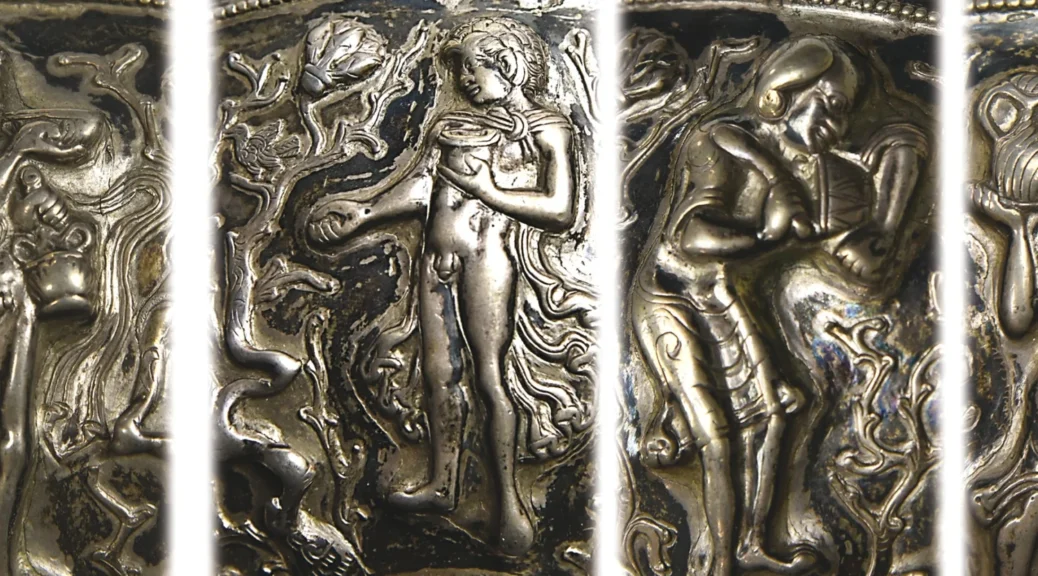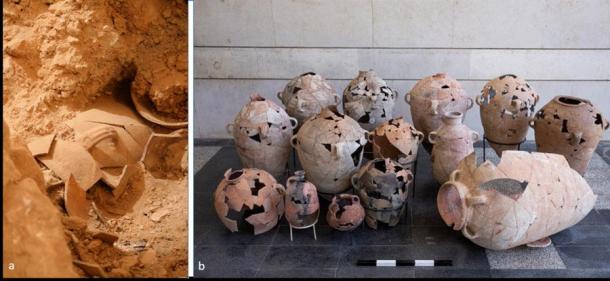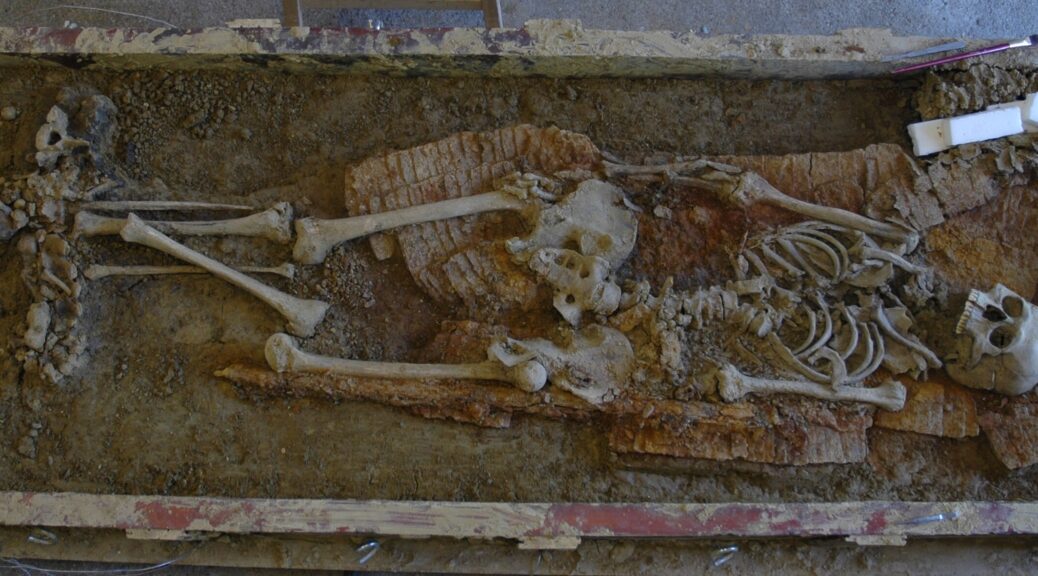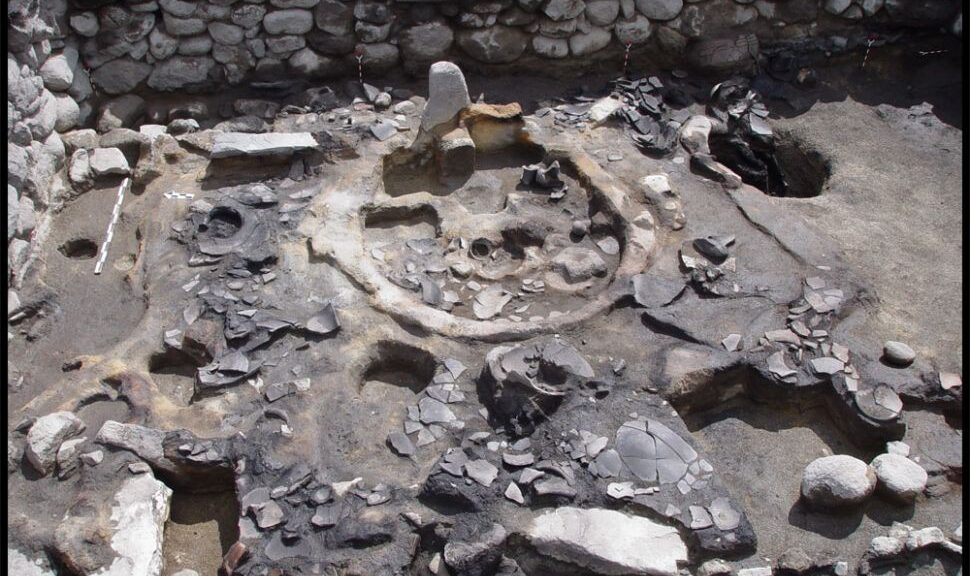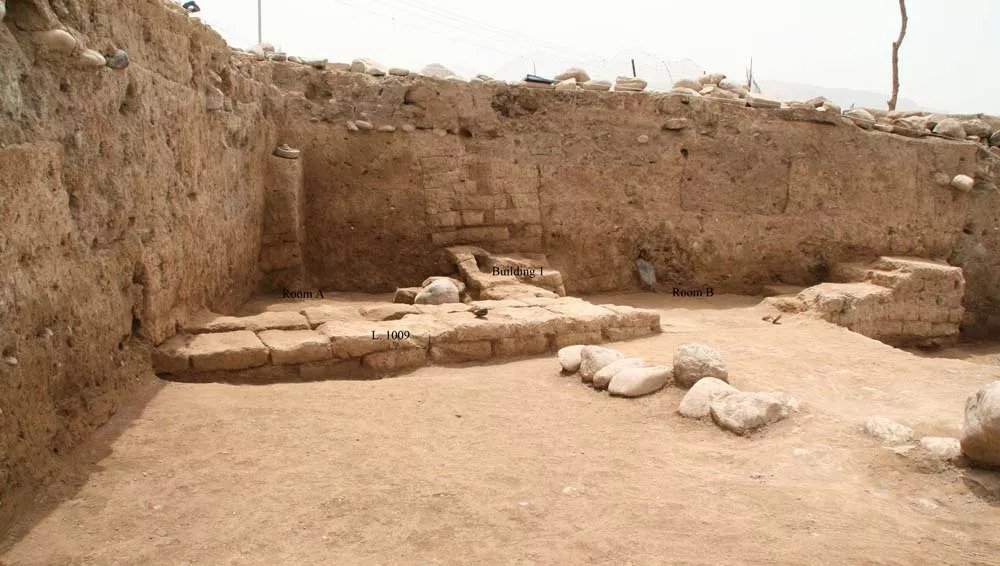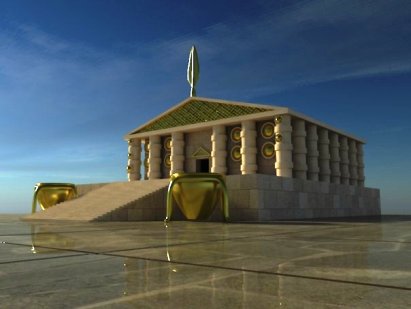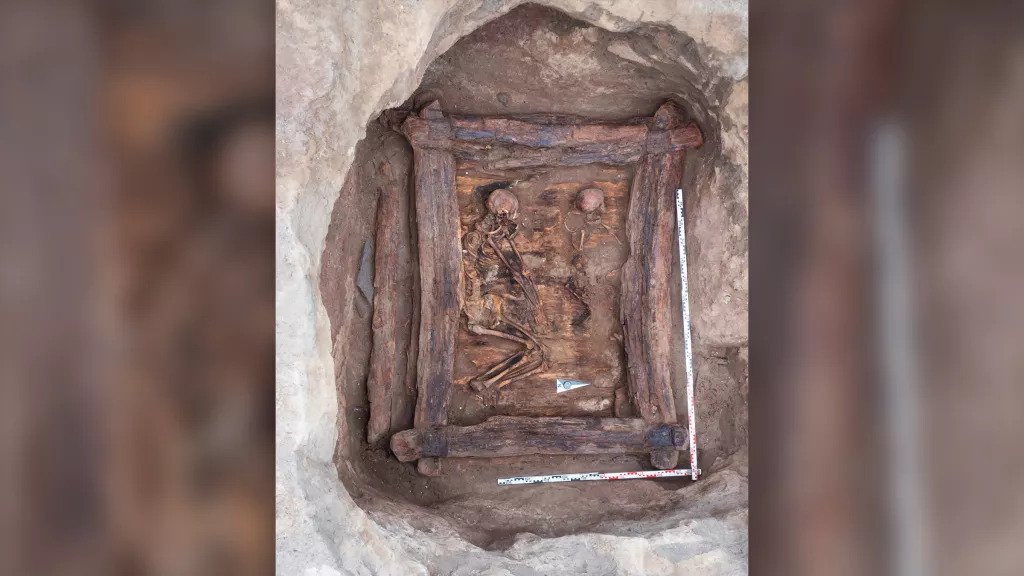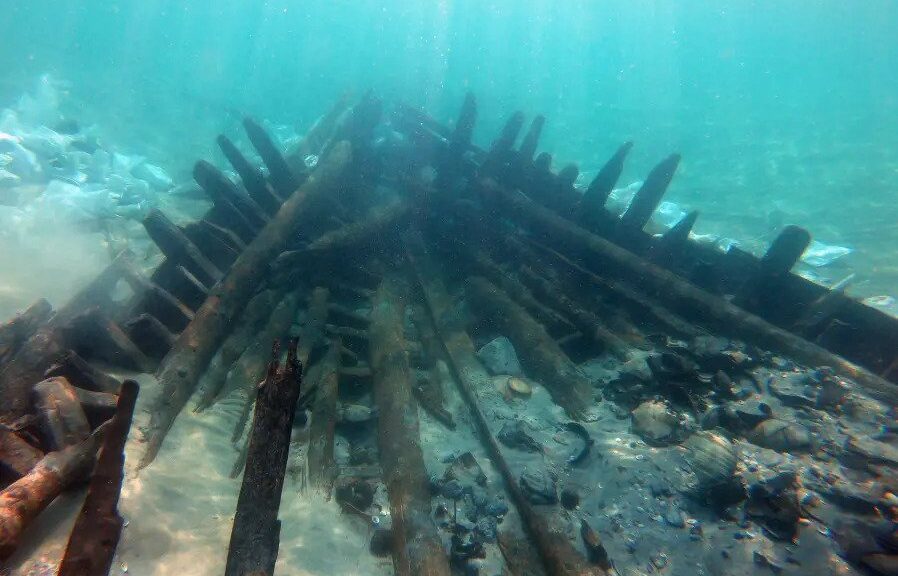Ancient Bowl From Tibet Shows Alexander the Great – the Jewish Version
An ancient silver bowl with Greek-style reliefs found in Tibet decades ago does not show scenes from Homer’s “Iliad,” as has been postulated. Rather, the bowl shows Alexander the Great and his servants, based on a Jewish version of the “Alexander Romance” dating to the fifth or sixth century C.E. that had been previously unknown, according to a new paper published in the Bulletin of the Asia Institute.
Alexander himself is shown three times on this bowl: once picking fruit from the Tree of Life, and twice drinking from the Fountain of Life, claim authors Anca Dan of CNRS, University Paris Sciences & Letters, and Frantz Grenet of the College de France.
The bowl also has the earliest known depiction in the Far East of the terrestrial Paradise, the two scholars say in their paper. Their innovative view of the bowl’s Jewish origin is based, among other things, on the fact that the nude figure they believe represents Alexander the Great, shown drinking the Water of Life and picking the frankincense from the Tree of Life – is circumcised, which was not a habit known among the Macedonians.

If Dan and Grenet are right about their interpretation of the dish’s Jewish origin, then the bowl indicates that Jews involved in long-distance trade along the Silk Road played a role in the evolution of the Alexander legends in the centuries following the king’s death. In short, this one wee bowl indicates Jewish influence in medieval Central Asia (between northern India, Afghanistan, Pakistan and Uzbekistan) centuries before the Arabic conquest.
Medieval fanfic
The earliest versions of the Alexander Romance – accounts of real and imagined exploits of the powerful ruler of ancient Macedonia – which were written in Greek, Latin, Armenian and Syriac, date to the third century C.E. and relate to the boy king’s military campaign that began in his homeland and reached as far as India. The main text of the Romance was wrongly ascribed to Callisthenes, Aristotle’s nephew and Alexander’s official historian. Two extant texts describe the Jewish legend that Alexander the Great arrived at the Garden of Eden. The first is a passage in Aramaic in the Babylonian Talmud, written sometime in the sixth century C.E. It relates that Alexander washed his face in the Water of Life and arrived at the Gate of the Lord, through which only the righteous may enter, based on Psalm 118:20: “He ascended along the length of the entire spring until he reached the entrance of the Garden of Eden. He raised a loud voice, calling out: ‘Open the gate for me!’” (Tamid 32b, Babylonian Talmud).
The second, Sefer Toldot Alexandros ha-Makdoni (the history of Alexander the Macedonian), is part of a collection of Hebrew texts compiled by Eleazar of Worms (now in Germany) in roughly 1325, which is preserved in a manuscript in Oxford. It describes how Alexander was circumcised by his doctors so that he could enter the Garden of Eden as a righteous person. The images on the bowl seem to combine elements from both the Tamid and the Sefer Toldot Alexandros ha-Makdoni. If so, they indicate that the Jews of Central Asia had developed their version of Alexander’s accession to Paradise before the Islamic conquest, Dan and Grenet contend.

In the Garden of Eden
The interior of the bowl is smooth, as befits practical tableware. The exterior bears a dense riot of imagery done in reliefs that project up to 9 millimetres above the silver surface, the authors explain. It shows six male figures. According to Dan and Grenet, Alexander himself is shown three times, once picking fruit from the Tree of Life, and twice drinking from the Fountain of Life. The researchers recognize two Indian carriers of the Water of Life, and a priest playing on an Indian drum with strings (dhol).
Between each man is a gnarled tree with a snake climbing up toward a nest. In each nest the birds are at a different stage of life: In one there are eggs, in another, a bird is feeding chicks, and finally, one nest shown empty could indicate that the serpent ate them. Between the two figures of Alexander picking fruit from the Tree of Life and drinking from the Fountain of Life, however, the birds are nesting in flourishing trees, as in an eternal spring, the authors explain. As for the Jewish bent of the Alexander depiction, the state of his penis is unmistakable even though the bowl is very small: 6.5 centimetres in height, 21 centimetres in rim diameter and with a capacity of 120 cubic centimetres, which is about half a cup. Its weight corresponds to 250 drachms, in keeping with standard measurements used in ancient Bactria and Sogdiana (4.43 to 4.55 grams).


Clearly, the absence of the monarch’s foreskin was of importance, which argues that the artisan or maybe the commissioner of the art was Jewish. The ancient Greeks did depict naked young men, frequently, but did not circumcise. Neither did Macedonians, or the Indians or Iranians conquered by the Macedonians, Dan observes.
Speaking of prohibitions, Jews aren’t supposed to show graven images and nudity isn’t a hallmark of Jewish art. The bowl may have been commissioned by a Hellenized Jew living in central Asia who adored Alexander but did not necessarily shrink at such depictions, the researcher suggests.
There are precedents of nudity in ancient Jewish art: for example, the synagogue of Dura Europos, a city that existed in Syria from 300 B.C.E. to the year 256 C.E., has frescoes showing people dressed to the nines but also a nude woman in the water – a maid or Pharaoh’s daughter herself – rescuing baby Moses.

Back to the bowl. Even if it was commissioned by a Jew, why would the conqueror have been shown thus trimmed? Because, according to the Jewish version of his “Romance” (from which only medieval versions survive), he had to be in order to visit the Garden of Eden, albeit briefly. The bowl, actually made of a silver alloy with a high concentration of copper, had been obtained in Lhasa half a century ago by Dr David Snellgrove, a professor of Tibetan Buddhist studies at the SOAS University of London, the authors say. The reinterpretation of it by Dan and Grenet was undertaken based on photographs of the bowl, which today belongs to a private owner in Japan who displays it in the Ancient Orient Museum in Tokyo.

Alexander in the altogether
Alexander the Great died young, aged just 32, but left a giant Hellenistic mark on culture wherever he went, which includes Judea. En route to conquering his nemesis Persia, the Macedonian forces he led rolled over Judea and seized control of Jerusalem itself in the year 332 B.C. Centuries later, in the first century C.E., historian Flavius Josephus was aware of (and wrote about) Alexander’s alleged visit to Jerusalem and his meeting with the priests (“Antiquities of the Jews,” 11.317-345). Never mind the veracity of the account; clearly, Alexander was intimately involved with the ancient Jewish world. He isn’t mentioned by name in the Bible though some choose to believe that the prophet Daniel foresaw him and the fate of his Macedonian empire. But accounts of Alexander’s life, and traditions and legends about the young king, appear time and again in other Hebrew literature. He appears by name in the First Book of the Maccabees – in fact, the first chapters are all about this industrious Macedonian. That first book was apparently written in Hebrew (going by its use of idiom) over 2,100 years ago, after the rise of the Hasmonean kingdom, a century and a half after Alexander’s death. The original version has been lost and all that remains is a Greek translation in the Septuagint that tells how Alexander conquered Judea and later, how his empire was shattered by his death.


Before addressing his seemingly Jewish trait, why should one think it’s Alexander at all (in three of the six cases)? Because the image on the bowl is of a young man whose hairdo complies with the classical canon, short and abundant, and is done in his specific hairstyle: two curls are flipped upward, away from the forehead, recalling a lion’s mane, Dan explains.
“Alexander was probably born when the Sun was in Leo. The lion was a symbol of kingship and Macedonian kings were showing themselves hunting the lion, as heirs of Heracles, the Greek hero who fought the Nemean lion,” she adds.
His depiction in the nude fits with the Greek version of the Romance, which has the emperor consulting with the Oracle of the Sun and Moon, at the end of the Earth, for which purpose nudity was de rigueur. “The bare Alexander has only a royal mantle or a scarf draped over his shoulder, a symbol of royalty in the Sassanian culture of Iran, which continued to influence Central Asia after the Hunnic invasions, in the 5th century C.E.,” Dan explains. The scarfed Alexander holds a long-necked flask in one hand, of a type known from Syria and Egypt in the 3rd to 4th centuries C.E. (so the silver bowl couldn’t date to before that, Dan argues). Such flasks were used to hold small amounts of precious liquid and here the researchers think the flask is supposed to hold the Water of Life, in keeping with the Jewish version of the Alexander legend – it is only in the Jewish version that the king himself, as opposed to his cook or other servants, attains the Water of Life.
Regarding the trees, Dan and Grenet suspect they’re frankincense-secreting trees of Boswellia serrata that grow in the Indus Valley, which Alexander partly conquered. Possibly the bowl-maker or person who commissioned it was involved in the incense trade. The Greek and Latin versions of the Alexander Romance describe his visit to a sacred Indian wood “full of frankincense and opobalsamum.”

In the trees are birds who sometimes escape the snake and sometimes don’t, images that may depict the fight between good and evil, Dan suggests. She and Grenet reject the explanation published in 1973 by Philip Denwood that the bowl represents an episode of Homer’s life, in which a snake that ascended a plane tree near Artemis’ sanctuary in Aulis ate eight chicks and their mother, and was then turned to stone, presaging the nine years of war between Greeks and Trojans.
The tree isn’t a plane tree, the authors point out, and the bowl doesn’t show eight chicks and a mother bird. None of the characters mentioned in the “Iliad” and nothing from the Greek temple in Aulis is depicted in this bowl.

Pseudo-letters to his mother
The Alexander Romance is comprised of various texts which were rewritten, revised, reinvented, rehashed, changed, and generally evolved throughout antiquity and Middle Ages. The scenes on the bowl could plausibly be based on two apocryphal letters ostensibly written by Alexander the Great that appear in a 5th-century Greek version of the Romance: one where he ostensibly tells his mother Olympias and his teacher Aristotle about his discovery of the Fountain of Life in the Land of Darkness and of the Blessed; and one about gathering aromatic plants (frankincense) around the Oracle of the Sun and the Moon, at the end of his expedition, as related in the pseudo-missive “Letter about the Marvels of India.”
And there you have it. A beautiful young man with classic artistic hallmarks of the young conqueror plus a very clearly circumcised penis, among incense trees, attended by servants. If Dan and Grenet are right about the identification of the iconic man on the bowl and about its origin, then this bowl – a “unique visual representation” of Alexander’s legend in the Jewish context – is also the earliest attestation of the Alexander Romance in the Indo-Iranian world, Grenet says.
The bowl was manufactured at the time of the Sassanian (aka Neo-Persian) Empire, which ruled from the year 224 to 651 C.E, in its eastern regions, which were already dominated by the Huns called “Hephtalites” who occupied Central Asia between 457 and 565 C.E. And if all this is correct then, Dan and Grenet suggest, not only ancient Greek and Roman and Indo-Iranian traditions but Jewish traditions too may have contributed to the awe we feel for Alexander to this very day, as well as to the image of Paradise in various cultures – even among the most eastward Zoroastrians. The base of the bowl is also interesting, in showing six fish in three pairs of two, possibly swimming in the paradisiac Fountain of Life after being resurrected following desiccation for consumption. The frankincense tree recalls the Tree of Life, with its serpent, and the two Alexanders on each side of the tree may correspond to the stereotypical image of Adam and Eve in Eden in Judeo-Christian representations as of the third and fourth century onward; or they may correspond with Zoroastrian representations of a couple in Heaven.

What about the Jewish prohibition on making graven images? Well, iconoclasm in Late Antiquity may not have been all it’s been thought to be, Grenet and Dan postulate. Depicting the king as a circumcised man allowed to visit the glory of Paradise does not smack of worship per se, but may be indicative of the Jewish appropriation of the figure of Alexander as one of “the righteous”: Jewish tradition goes so far as to suggest that the great conqueror, upon encountering the high priest of the Jews in Jerusalem, bowed before him. It bears adding that to this day some Jews name their children Alexander but nary a one is named, for instance, Ahasuerus.
Possibly, then, living at some point in the 5th century or early 6th, in the Hephthalite Empire that ruled central Asia at the time, was a well-to-do Jew – there were many Jews in that region. This one had become imbued with Hellenic culture, Dan and Grenet sum up; and he wished to salute Alexander, protector of his religion and his people in the form of this beautiful bowl showing stories of the legends of the young king, cut in the only way he could possibly have entered Paradise as the story says.
